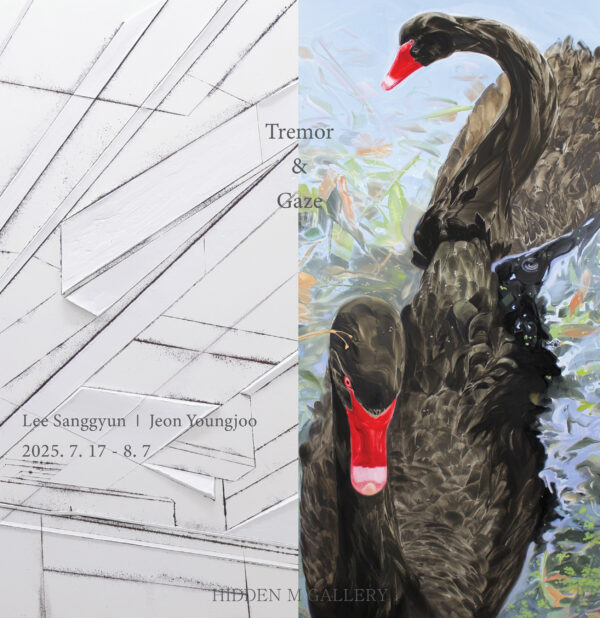재현의 방법
| [GALLERIES] ONE AND J. GALLERY
2020. 12. 17 – 1. 31
강석호, 김혜원, 노은주, 박정인, 서동욱, 손현선, 이호인, 정용국, 조우빈, 최모민

본다는 것은 망막에 상이 맺히는 것 이상의 의미를 갖는, 세상을 이해하기 위한 총체적인 감각이다. 모리스 메를로 퐁티는 그의 저서 『눈과 마음』에서 보는 행위는 ‘거리를 둔 소유’이며, 보는 것은 ‘의지’가 아닌 ‘사건’이라고 말한다. 그에 의하면 나의 시지각과 타인의 시지각을 모두 이해하게 될 때 – 내가 보면서 동시에 보여지는 총체적인 상황을 이해하게 될 때 – 우리는 모두가 가시적 세계에 놓여져 있음을 인식하게 된다. 다시 말해 우리는 시지각을 통해 세계와 관계를 맺는다. 메를로 퐁티는 ‘사건’을 이러한 ‘사유’로 전환시키기 위해서는 행위가 필요하다고 말한다. 본 것을 그린다는 것은 어쩌면 그가 말한 ‘행위’라고 해석할 수 있을 것이다. 그 행위를 통해 탄생한 회화는 다만 물감 덩어리, 또는 이미지의 복제가 아닌, 세상과 관계를 맺는 또 하나의 존재다. 예술가는 자신의 작품을 통해 “세상에 대한 견해를 표명하는 것이 아니라, 자신의 시지각을 몸짓으로” 만든다.

몇년 사이에 등장하기 시작한, 가상의 이미지를 다시 회화로 옮겨 그린 작품들을 떠올리면, 그의 철학은 더욱 흥미롭게 느껴진다. 가상과 현실이 뒤섞이고, 비물질적 접촉이 일상의 전반에 영향을 주는 시대에 작가들은 왜 그것을 다시 물질화 하고자 하는 것일까? 그들의 눈은 왜 그저 가상 안에 머물기를 거부하고, 다시 물질 세계로 돌아오고자 하는 것일까?

전시 《재현의 방법》은 이러한 질문으로 부터 시작해, 매혹된 듯 주변의 현상을 관찰하고, 관찰한 것의 형상을 다시 작품으로 옮김으로써 사유를 일으키고자 하는 열명의 작가들을 초대하였다. 강석호(b. 1971)는 신체의 부분을 클로즈업하여 화면 가득 그린다. 확대된 이미지는 연결된 서사적 맥락, 인물의 정보 없이도 그 자체로 어떤 사건이나 욕망을 드러낸다. 김혜원(b. 1993)은 바라보고 그리는 행위에 집중하기 위해 그림을 그리는 각 단계에서의 불필요한 부분들을 제거하고 최소한의 행위에 몰입하여 그림을 그린다. 그렇게 그려진 그의 그림은 그려진 대상보다, 회화의 표현과 기법에 주목하게 하여 일상 속 물건과 풍경을 다른 시각의 장 안에 놓는다. 노은주(b. 1988)는 도시 풍경을 구성하는 사물들의 본질적인 형태를 그린다. 그의 회화는 일종의 정물화이자, 풍경화로, 운동-시간을 내포한, 소멸과 생성 사이에 잠시 출몰하는 형태를 포착한다. 박정인(b. 1991)은 연필과 종이라는 친숙하고 미완결적인 재료로, 빛이라는 조건부 아래 일시적으로 생성되는 대상을 그린다. 구체적 외형이 시간과 빛에 의해 그것의 그림자로서 나타날 때 미세한 흐름으로 연결되어 감각되는 대상, 시공간, 시선의 관계를 드러낸다. 서동욱(b. 1974)은 영화적 연출기법과 회화적 연출기법을 교차한 인물 초상화를 그린다. 그는 인물의 미세한 표정에서 순간적으로 드러나는 복합적인 감정을 표현하기 위해 세밀한 회화적 묘사를 추구한다. 손현선(b. 1987)은 시각의 바깥에 존재하나, 감지할 수 있는 것들의 시각화에 관심을 갖는다. 그의 작품은 시지각의 총체적 감각을 통해 대상을 이해하고, 그것을 화폭으로 옮기기 위한 테크닉과 재료, 프로세스를 연구의 결과이며, 비시각 대상의 시각 대상으로 전환되었을 때 그것이 유사한 감각을 일으킬 수 있는가에 대한 질문을 던진다. 이호인(b. 1980)은 풍경화로서의 도시 야경을 그린다. 그는 도시가 갖고 있는 표면적, 이면적 특성들과 함께 대상에 대한 자신의 이해와 감정을 함께 담아내기 위해 속도감 있는 스트로크를 체화하여 표현한다. 정용국(b. 1972)은 강, 호수, 바다의 물결을 그린 남송(南宋)의 화원 마원(馬遠)의 십이수도(十二水圖) 화첩을 재전유하여 Flow 시리즈를 그렸다. 습윤한 먹의 붓질로 그려낸 그의 그림의 검은 먹색은 푸른 물결로, 흰 종이는 눈부신 빛으로 경험하게 하며, 대상의 고유한 특성을 다르면서도 유사한 감각으로 환유한다. 조우빈(b. 1993)은 대상에 대한 묘사를 극대화 시키며, 물감과 나무, 레진으로 형상을 만든다. 실제 대상의 형상을 충실하게 따르면서 전혀 다른 물질과 스케일, 표면으로 이루어진 작품으로서의 대상은 원본을 떠올리게 하기보다는 오히려 언캐니한 감각을 불러일으키며 신체적 사유를 이끌어낸다. 최모민(b. 1985) 은 실제로는 벌어질 것 같지 않은 상황들을 연출하여 촬영하고 그것을 다시 회화로 옮긴다. 그림이라는 특성과 그림 속 상황은 작가의 심리가 반영된 초현실적 묘사로 보이지만, 그림의 부분들은 실제 벌어진 사건이기도 하다. 그의 그림은 사실과 연출, 심리와 현상이 교차되면서 다층적인 아이러니함을 드러낸다.

어떤 것을 오랫동안 응시하고 그것의 형태를 떠냄으로써 존재에 다가가고자 하는 것은 정신과 육체의 이분법에서 벗어나고자 했던 메를로 퐁티의 철학 아래에 있다. 작가의 시선이 세계로 향해 현상을 관찰하고, 관찰한 것을 다시 육화한다는 점 역시 그렇다. 물리적 덩어리를 가진 작품은 세계 속에 존재하는 어떤 것이며, 다른 것들과 이웃하여 관계를 맺는 무엇이다. 그런 점에서 구상화에서의 조형성에 대한 문제는 현상과 존재에 대한 이해의 뒤에 따라오게 된다. 즉 캔버스 옆에 놓인 사건과 캔버스 위에 그려진 그림의 관계, 눈과 손이 결합된 신체가 만들어내는 관계가 그에 앞서 놓여진다. 선과 색, 그리고 구성의 문제는 또 하나의 존재로서의 이 그림을, (또는 조각을) 어떻게 사유의 대상으로 만들 것인가 하는 문제에 의해 정해진다. 대상의 표면을 몇번이고 훑어내는 눈과 손은 세계에 대한 지속적이고 끈질긴 질문이며, 내 앞에 – 또는 옆에 – 놓여진 것과 내 존재와의 관계를 쉼 없이 탐색한 결과이다. 전시 《재현의 방법》은 이러한 작품들을 더듬어가며 만들어낸 사유로서의 예술을 향한 지도라고 해석해도 좋을 것이다.

ONE AND J. GALLERY 원앤제이 갤러리
서울시 종로구 북촌로 31-14
+82 2 745 1644











